Coordinator: Valeria Conte
Phone: 049 8068304
Mail: valeria.conte@lnl.infn.it
CSN5 deals with technological, interdisciplinary and accelerator physics research. At the same time, it promotes the use of technologies and innovations developed in the physical field in other sectors. The prototypes or accelerators created can be used in other areas of scientific research with an economic and social impact.
Index
4MiCA
National Responsible: Valeria Conte (INFN LNL)
Local Responsible: Valeria Conte
The 4MiCA project has as its objective the engineering of a miniaturized proportional gas meter (mini-TEPC) developed during the CIMICE project for the microdosimetric characterization of charged particle beams used for tumour treatment (hadrontherapy). This implies the standardization of construction and assembly procedures, to ensure the reproducibility of the response, and the integration of the sensor with an automatic control and data analysis system that can be easily used in the clinical setting. The project is carried out in collaboration with De.Tec.Tor, a company specialized in the production of medical devices for hadrontherapy, and CNAO. Once introduced in the clinical environment, the mini-TEPC can be used to monitor physical quantities related to the relative biological effectiveness (RBE), and therefore to optimize the treatment plans.
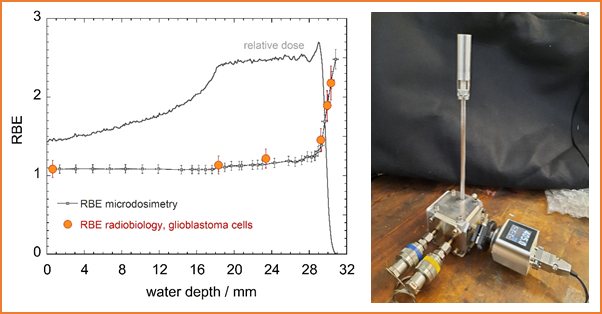
ASIDI
National Responsible: Valentino Rigato (INFN LNL)
Local Responsible: Valentino Rigato
The project concerns the development of new irradiation and single-particle implantation techniques and the related detection techniques with sub-micrometric resolution for the study of the spatial response of radiation detectors, the localized functionalization of advanced materials and the creation of new quantum devices, using the ion beams of the AN2000 electrostatic accelerator of the Legnaro National Laboratories.
The possibility of locally altering, at the atomic level, the quantum-mechanical properties of a material with the introduction of a foreign chemical species and / or with a controlled modification of the existing chemical bonds, constitutes the starting point for generating quantum systems electrically, optically and magnetically active. Furthermore, the possibility of studying the response of a pixel detector structured for 2D and 3D tracking in areas on the sub-micrometric scale (e.g. near the edges of the active areas …) is of vital importance for the development of avalanche silicon detectors with an internal multiplication that merge position and timing.
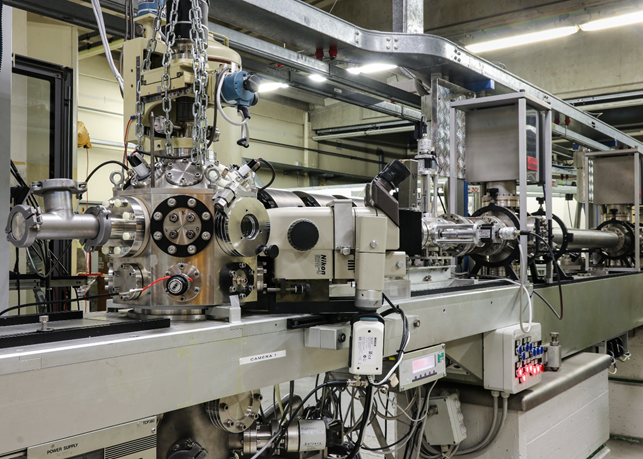
CIMICE
National Responsible: Anna Selva (INFN LNL)
Local Responsible: Anna Selva
Microdosimetry measures the stochastic fluctuation of energy deposition at the micrometre scale, which is closely related to the biological effectiveness of ionizing radiation. The reference detectors are the tissue-equivalent gas proportional counters (TEPC), built with materials having an elemental composition similar to that of biological tissue. The CIMICE project, funded by INFN under the 2018 call for young researchers, aims to develop a miniaturized TEPC (mini-TEPC), optimized for use in therapeutic carbon ion beams. The photo shows a transparent prototype of the new detector, which is more robust and easier to operate than the existing ones.
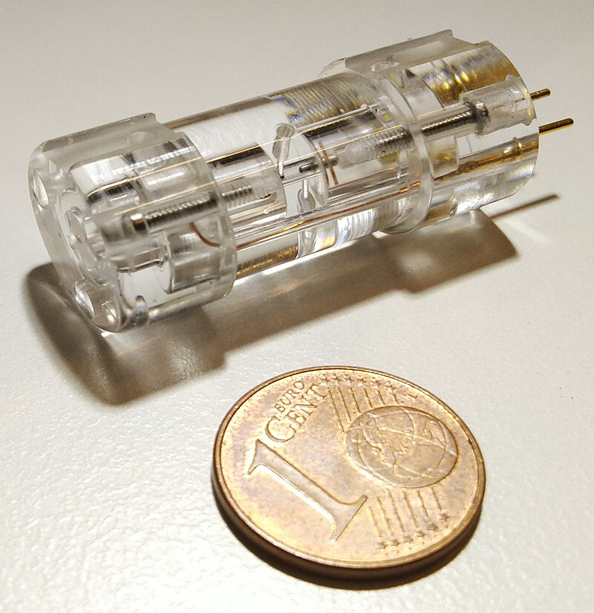
DEMIURGOS
DEtector of Matrix Isolated Unreactive Rare Gas Organized in Solid
National Responsible: Giovanni Carugno (INFN Sezione di Padova)
Local Responsible: Antonio Dainelli
The research program is devoted to the development of a novel class of particle detectors aimed to Dark Matter searches as well as the study of others feeble interacting phenomena characterized by low energy deposition. Exploiting the forefront development in the fields of cryogenics, lasers and ultra-pure materials, we propose innovative schemes for particle detectors that improve the current standard of energy threshold. The key-point of the proposal is to probe, through laser spectroscopic techniques, atomic or molecular energy levels of atoms embedded into unreactive environments. These detection schemes, together with inverse laser bremsstrahlung within high density gases, will produce devices capable to detect single excitation phenomena in the solid matter opening the possibility to detect energy releases of the order of eV. These approaches will provide a completely new class of detectors that could be used for many applications such as Dark Matter (DM) searches, neutrino physics and radiation detection. In particular, the so-called DM, that represents about the 27% of the Universe composition, plays a central role in the current understanding of the Universe and to be able to probe possible DM constituents it is necessary to improve the performances of the current detectors making them more efficient in terms of energy threshold and mass.
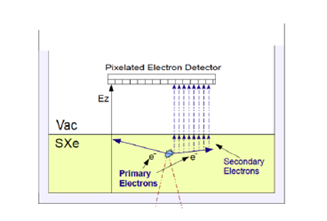
ENTER-BNCT
National Responsible: Saverio Altieri (INFN Sezione di Pavia)
Local Responsible: Enrico Fagotti
The MUNES (MUltidisciplinary NEutron Source) project aims at the realization of an intense source of thermal-epithermal neutrons via the interaction of 5 MeV protons onto a beryllium target. A high intensity (30 mA) proton beam is provided by a Radio Frequency Quadrupole, to reach a neutron intensity of 1014 s-1. Neutrons are produced via the 9Be(p,n)9B reaction. The emitted neutron spectrum is centered at 1.2 MeV, and its energy is then reduced to the thermal-epithermal range by a proper moderator made of heavy water, PTFE and graphite. The final neutron spectrum is designed to be suitable for Boron Neutron Capture Therapy (BNCT). ENTER-BNCT aims at the study of the target performances and to the optimization of its design. For such purpose, a low-power test source was designed and installed on the +15° beam line at the CN accelerator. With a beam current of 3 μA at 5 MeV, the nominal power density of 600 W/cm2 can be reached by means of proper collimation, allowing target integrity tests. Beside this main activity, the neutron source supplies a neutron flux of 1.2×106 n/(s·cm2) at the disposal for the experiments.
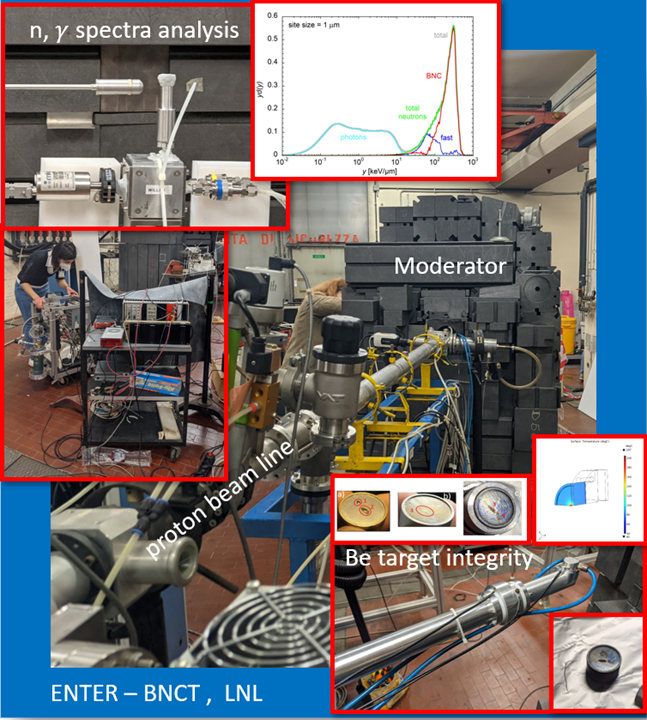
FIRE
flexible organic ionizing radiation detector
National Responsible: Beatrice Fraboni (INFN Sezione di Bologna)
Local Responsible: Sara Carturan
The main goal of this project, funded by the INFN Vth commission, is to produce a fully flexible photodetector, able to reveal ionizing particles such as protons, X-rays, g-rays and neutrons. This device can be realized in a direct configuration (PHOX), where the organic semiconductor directly converts the ions/photons deposited energy in electrical signal, read by the flexible photoconverter. On this topic the RU of INFN-Bologna is the leading group, supported by the RM3 and INFN-NA units’ skills in the manufacture and optimization of the phototransistor. As for the indirect configuration (NEPRO), the thin, flexible siloxane scintillator (PSS) is synthesized by the LNL unit, in collaboration with TIFPA unit. In this case, the scintillation light is read by the Organic Photo Transistor (OPT). The device is tested under irradiation with low energy protons @AN2000 accelerator of LNL and LABEC (INFN-FI) and with high energy protons @TIFPA accelerator, used for the proton therapy in Trento. In the final application, the fully flexible device will work as dose meter during a proton therapy treatment. The use of this device in close proximity to the tumor volume to be irradiated will preserve the surrounding healthy tissue from damaging. Aiming at this task, the scintillator coupled to the Optical Photo Transistor (OPT) has been validated as for light emission using an UV calibrated source, whereas the scintillation light and its stability with irradiation time has been collected using a power meter. In the next two years, conclusive validation of both direct (PHOX) and indirect (NEPRO) flexible devices will be pursued.
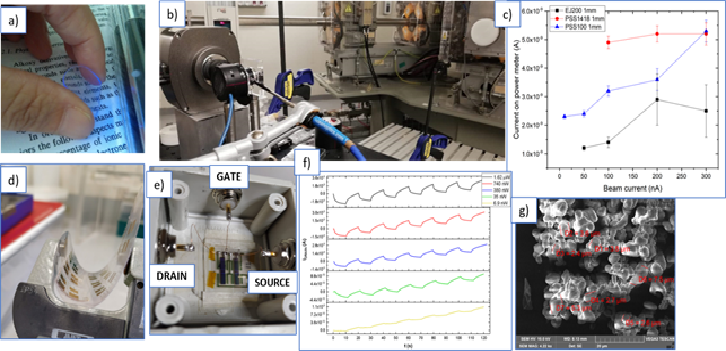
ION2NEUTRAL
National Responsible: Marco Cavenago (INFN LNL)
Local Responsible: Marco Cavenago e Michele Comunian (INFN LNL)
Ion2neutral (2020-2024) experiment is an integrated project to develop ion sources, ion coolers, Gas Electron Multiplier detectors (for gamma/neutrons), high current ion beams, and computational techniques of interest for project ITER and other fusion reactors, and for SPES LNL project. The experiment is based at four INFN branches (BA, LNL, MI and MIB) and is performed in synergy with project INFN-E (Energy), the ”Consorzio RFX”, Padua, and the project PRIMA (Padua Research on ITER Megavolt Accelerator), which is developing the neutral beam injectors for ITER (nominal beam power 40 MW, that is 40 A of negative ion beam / 1 MV acceleration, for each injector).
Ion2neutral (I2N) research activities are organized in five workpackages:
WP1: physics and technology of H− ion sources, with comparisons of magnetic configuration and conditioning effect (gas or Cs ovens) in radiofrequency (rf) ion source NIO1 (and other sources), and energy recovery. Operation and development (after our design and construction supervision) of a versatile test ion source NIO1 (Negative Ion Optimization 1, Fig. 1), aiming at producing 9 beamlets of H- ions up to 15 mA each, 60 kV acceleration voltage; beam is continuously working, or has a duration comparable to ITER specification, as 3600 s. Financed with external funds.
WP2: Manipulation and Cooling of rare ion beams: beam trapping and cooling with gas collisions in rf linear traps/plasma traps, as Eltrap or Duel, and installation in Eltrap of a prototype RFQC (Radio Frequency Quadrupole Cooler); collisional simulation with and beyond (see Fig. 2) Monte Carlo techniques. Construction of specialized rf matching networks and electrode biasing systems are also included.
WP3: development and construction of triple GEM neutron detectors (about which INFN has a long tradition also spread over other experiments and branches); in this case, detectors may have a fast temporal resolution and can give information on photon/neutron energy and therefore on the production reaction, or on the onset of high voltage breakdowns, see Fig. 3. Therefore GEM usage is extended to detect not only neutrons but also low energy photons (from 1 to 20 keV) which are precursors of HV breakdown, in ion sources and in a 80 kV test facility (HVPSGF, High Voltage Padova Short Gap Facility).
WP4: positive ion sources with high current (IFMIF-style); physics of high current H+ beams, backstreaming ions and secondary plasmas with tests on ion source TRIPS. Design and collaboration to construction of diagnostic beam line, equipped with Infrared camera, FES (Fast emittance scanner) RFEA (Retarding Field Energy Analyzer), and test points for energy recovery plugin, see fig 4. Moreover, since additive manufacturing is emerging as a new technique for accelerator parts, especially grid electrodes and highly cooled beam dumps, a test station for them is also reserved.
WP5: theory of ion sources and of particle beams (H± ions and electrons) in strong space charge condition. Simulation tools depends on participating branches, and ranges from general purpose multiphysics codes to specialized beam tracing codes; in addition macro-codes are in-house developed, to surpass the granularity error of standard ray tracing (typical of previous codes) and to treat collision with and beyond Monte Carlo techniques (i.e., second moments of Fokker Planck equation). Accumulation points of regenerative ion-electron cascades in high voltage electrode system and prediction of location of voltage breakdown in high vacuum environment.

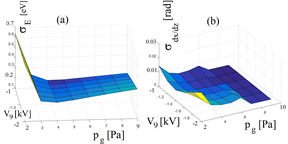
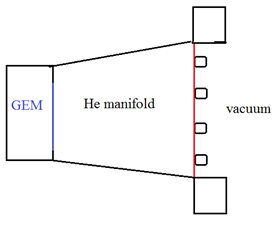
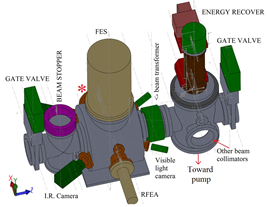
National Responsible: Alberto Andrigetto (INFN LNL)
Local Responsible: Stefano Corradetti
The development of a new radiopharmaceutical is a long process, and several years are required for its introduction in clinical trials. Considering both the relevance of 111Ag as radiopharmaceutical precursor for its nuclear and chemical properties, and the promising results obtained with the previous two-years ISOLPHARM_Ag experiment, a new three-years experiment, ISOLPHARM_EIRA, is ongoing. The ISOLPHARM_EIRA experiment foresee the interaction between different disciplines from Physics to Chemistry and Radiobiology.
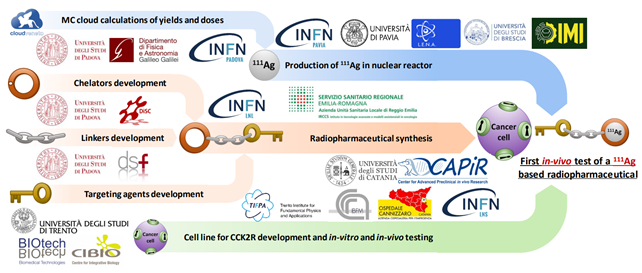
The physics task is mainly devoted to explore the possibility to supply the first batch of 111Ag aimed at first radiochemistry studies and the eventual radiolabeling of the first compounds, by using “traditional” reactor-based approaches but also to develop the tools needed when the ISOL facility will be operational: in particular the definition of a procedure for the quality control of the collected radioisotopes and the exploration of the feasibility of the efficient laser ionization of silver. The 111Ag will be produced at the TRIGA Mk II Research Reactor at the LENA facility.
The radiochemistry task is aimed at moving a step forward in the development and characterization of Ag–based pharmaceutical compounds. Furthermore, the capability to chelate Cu radioisotopes, or the synthesis of fluorescent linkers will be studied, to provide the opportunity to test in-vitro and in-vivo the newly developed molecules. Finally, the chemical purification of 111Ag from its pseudo isobaric contaminants will be further explored. The biology task foresees in-vitro and in-vivo studies for the evaluation of the affinity of the developed drugs with the selected cellular target as well as the observation of their behavior in dynamic conditions, in particular the best derivatives will be injected into mice bearing CCK2R tumor and examined by 2D image system following the pharmacokinetics at different time points to determine their effectiveness as imaging agents. Therapeutic effects of the compounds will be assessed by comparing tumor xenograft growth in mice that received the administration of the radiolabeled compounds versus the untreated control group. In vivo imaging experiments with radiolabeled compounds will be performed at CAPIR – Center for Advanced Preclinical in vivo Research.
METRICS
National Responsible: Juan Esposito (INFN LNL)
Local Responsible: Juan Esposito
The Multi-Modal Imaging (MMI) is the recent development in the hybrid imaging procedure in diagnostic medicine, by nuclear imaging techniques, through the matching between two of the modality already available nowadays, which allow to acquire information of different (and complementary) kind: Positron Emission Tomography (PET) and Nuclear Magnetic Resonance (NMR). CT and MRI images allow for a three-dimensional reconstruction of the anatomical structure. Conversely, PET, SPECT scans allow a deep penetration inside the mechanisms of how organs work, down to internal cellular level, aimed at collecting information at molecular level. Therefore, by combining images with a different diagnostic content, the understanding of the clinical picture (down to molecular level) may be thus obtained.
However, in order to obtain a true “fusion” (i.e. matching) in the information acquired by PET/SPECT and MRI hybrid facilities, both the contrast agent and the radiopharmaceutical product must be CHEMICALLY IDENTICAL. It’s always very hard to find out a chemical compound that can behave, at the same time, both as a paramagnetic contrast agent and a radioactive tracer having nuclear decay properties useful for PET imaging. Manganese compounds, having the same chemical composition, can be prepared using both radioactive 52Mn/51Mn isotopes and paramagnetic stable isotopes and can be used as MRI and PET agents. Thus, a new type of unprecedented PET/MRI hybrid diagnostic imagining may be opened, characterized by a PERFECT MATCH between the chemical and biological properties of the two imaging probes.
Main goals of METRICS experiment are basically aimed at providing an answer to the following questions:
1. How can we produce Mn52/Mn51 in its purest radionuclidic form, (i.e. in high activity) NO CARRIER ADDED (NCA) form?
2. May we find out a biocompatible carrier that can allow to keep the paramagnetic properties of Mn, in order to be able to carry out (in the future) in vivo studies, acquiring hybrid PET/MRI images?
More information on the project are here available.
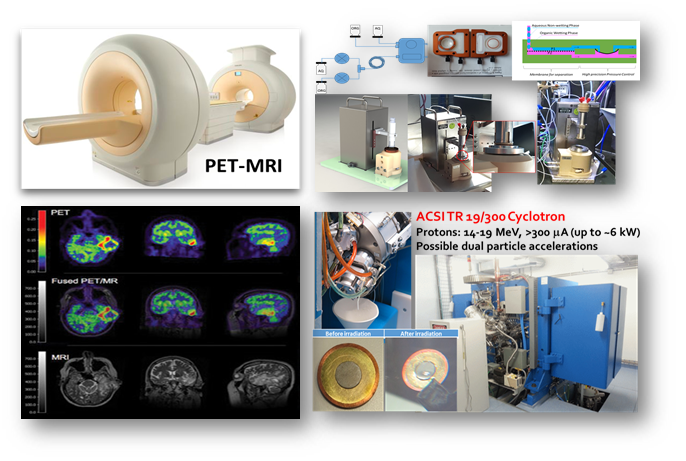
MICROBE_IT
National Responsible: Chiara La Tessa (INFN TIFPA)
Local Responsible: Valeria Conte
The MICROBE_IT experiment aims to develop a new model for the RBE (Relative Biological Effectiveness) of ionizing radiation, to improve the outcome of radiotherapy treatments with charged ions. Unlike existing models which mainly consider average quantities, it is based on the experimental measurement of the probability distribution of energy deposits at the micrometric scale (microdosimetry) with different detectors. The model predictions are then compared with cell survival experiments made in the same radiation field, to optimize the model parameters.
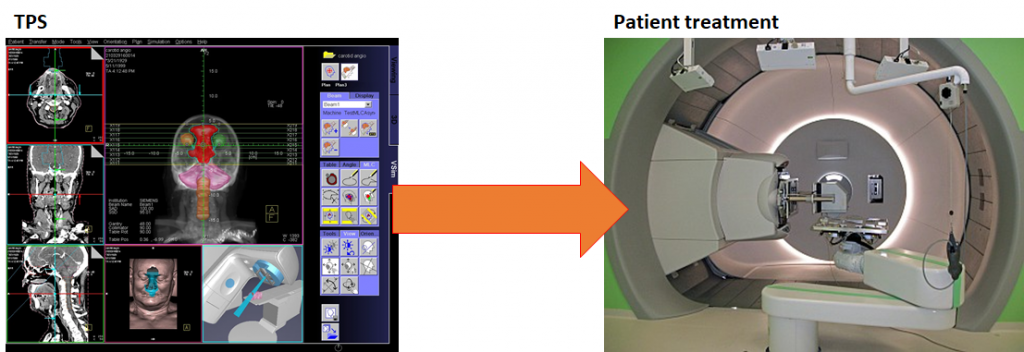
MOPEA
Realization of a Modular Optcally-Powered Electrostatic Accelerator prototype
National Responsible: Pierluigi Zotto (INFN Sezione di Padova)
Local Responsible: Piergiorgio Antonini
The project is focussed on the design, set-up and test of an innovative optically powered electrostatic accelerator prototype in the megavolt (MV) range, with superior performance and lower projected cost with respect to the current state-of-the-art.
Electrostatic accelerators, with currents up to tens of microamperes, can be used in many applications, e.g. material analysis by proton-induced X-ray emission or ion implantation. Existing accelerators are based either on van de Graaff or Cockcroft-Walton high voltage (HV) generators, whose major drawbacks are cost and large dimensions. The size is dictated by the voltage partition which cannot, in the current technology, be more than 30-50 kV. Furthermore the HV system needs to be inserted in a large vessel filled with an inert gas at several bars of high pressure in order to avoid sparks.
The proposed accelerator is based on a recent technique, developed by the proponents and proved in 2016, which provides the high voltage through series connection of lower voltage stages made of independently stabilized generators each one providing HV settable in the 12-100kV range with 4W available power.
All the power needed for the operation is supplied to each stage by laser light fed to photovoltaic cells through optical fibers. The series connection of many high voltage stages is allowed by the all-optical feeding scheme which decouples each stage from ground reference; the maximum attainable voltage is thus only limited by insulation of the last stage with respect to the mechanical structure.
The modular approach in the electrostatic accelerator design is allowed by the inherent floating nature of the HV generators. The aim of this project is towards a further improvement of the modularity of the design by producing fully independent accelerator modules, each one providing 300-500 kV which could be connected in series to get the required beam energy.
The overall impact of this project will be the availability of safer, cheaper, easier to maintain and more stable electrostatics accelerators.
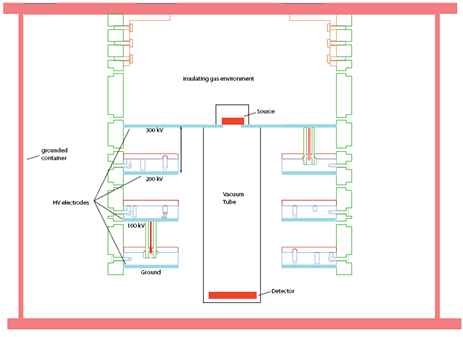
N3G
National Responsible: Davide De Salvador (INFN Sezione di Padova)
Local Responsible: Daniel Napoli
“Seeing” gamma rays is useful for understanding the nature of nuclei, stars and the human body! The eyes that make it possible to do this are increasingly sophisticated detectors. N3G is a project to develop new detector manufacturing technologies that allow measuring the direction and energy of gamma rays while resisting high radiation fluxes. For this purpose, we study how to treat one of the purest materials that man has ever manufactured: hyperpure germanium. In the figure on the left we see a detail of the laser apparatus that is used to modify the electronic properties of the germanium surface, on the right an example of a segmented detector, i.e. divided into sectors that allow for the localization of gamma rays.

NEPTUNE
National Responsible: Giacomo Cuttone (INFN LNS)
Local Responsible: Valeria Conte
Compared to conventional radiotherapy, proton beams allow to treat deep tumors minimizing the damage to surrounding healthy tissue, thanks to the different characteristics of their interaction with matter (in particular, their well-defined range). However, protons have a relatively biological effectiveness (RBE) which is only 10% higher than photons. An enhancement of RBE has been recently observed when the tumour tissue is loaded with 11B atoms. The aim of the NEPTUNE project is to study the physical mechanisms underneath this enhancement. The role of LNL concerns the microdosimetric characterization of the proton-Boron reaction.
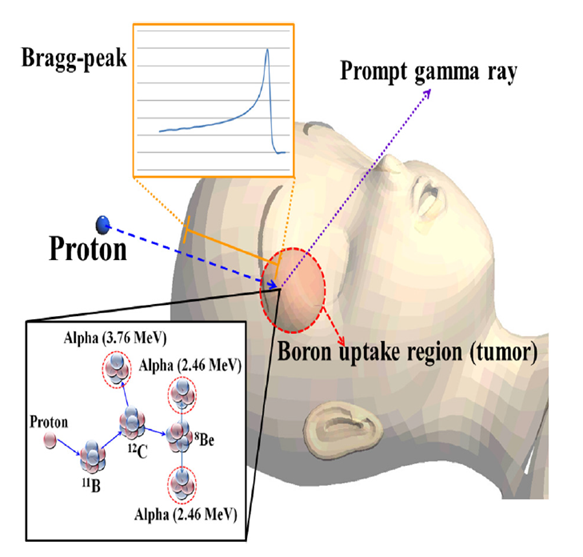
NIRVANA
National Responsible: Valeria Conte (INFN LNL)
Local Responsible: Valeria Conte
The biological action of ionizing radiation begins at the DNA level (nanometre scale), and the severity of the damage produced is closely related to the number of ionizations produced within distances of a few nanometers. To date, only three detectors in the world are able to experimentally measure the number of ionizations at the nanometer scale. One of them, the Startrack electron counter (in the photo) is installed at LNL. These devices are very bulky, designed for use in research centres. The NIRVANA experiment, on the other hand, aims to develop transportable nanodosimetric devices, suitable for use in clinical centres.
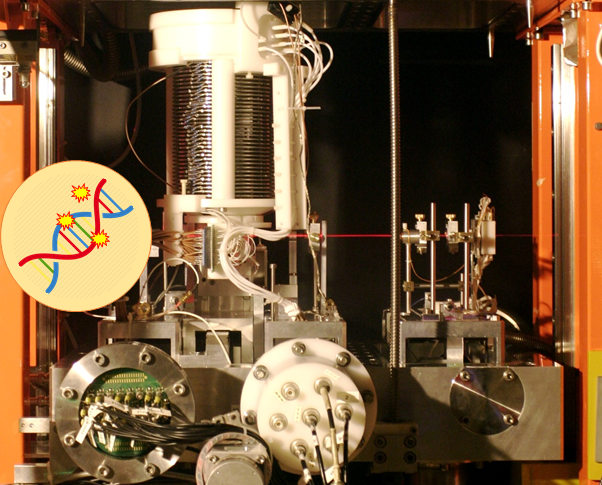
QUANTEP
QUANtum Technologies Experimental Platform
National Responsible: Andrea Salamon (INFN Sezione di Roma 2)
Local Responsible: Valentino Rigato
The QUANTEP project aims at the development and implementation of a complete Silicon Photonics Integrated Circuit for Quantum Computation with linear quantum optics circuits and single photons. A prototype of this kind of circuits is the universal two qubit Controlled-NOT (C-NOT) gate. This scheme makes use of linear, coincidence basis gate that performs all the operations of a controlled-NOT gate and requires only single photons at the input. This scheme could be a useful test-bed for the implementation of more sophisticated quantum circuits, which eventually will require on-chip single photon sources and detectors.
The technology selected for silicon photonics integrated circuits is IHP SG25PIC, which is a 250 nm Silicon On Insulator CMOS process. Special production process are foreseen in which a reduced set of masks is used in the standard Multi Project Wafer runs and some special reworking is done, after the run, in research facilities of the QUANTEP team.
The quest for single photon sources will be performed through ion implantation in silicon with the aim to identify appealing classes of emitter centers in the telecom C-band.
For the detection stage, two solutions will be studied: an integrated InGaAs SPAD and an integrated Bi2Se3/n-Si heterojunction. Bi2Se3 is a topological insulator, which efficiently absorbs IR light and delivers the photocharges to the external circuit without backscattering due to its Dirac–like metallic surface.
The potential of novel quantum-device concepts, realized by using as basic building blocks heterostructured semiconductor nanowires, graphene and other 2D materials will be explored focusing on their capability to provide the control over light-matter interaction mechanisms, such as polarization modulation.
The integrated linear optics quantum circuits will be characterized and the logic tested in the fully integrated version.
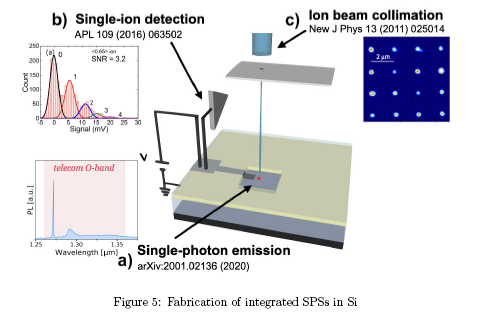
REMIX
Research on Emerging Medical radIonuclides from the X-sections
National Responsible: Gaia Pupillo (INFN LNL)
Local Responsible: Gaia Pupillo
REMIX, acronym for “Research on Emerging Medical radIonuclides from the X-sections”, is an experiment based at LNL in the framework of LARAMED (link). REMIX involves also the INFN divisions of MI, PD and PV, in collaboration with the ARRONAX facility (Nantes, France), the Sacro Cuore Don Calabria (SCDC) hospital (Negrar, VR) and the Istituto Oncologico Veneto (IOV-IRCCS). The project aims to find out the best nuclear reactions to produce the theranostic radionuclides 47Sc, 149Tb, 152Tb, 155Tb and the therapeutic 161Tb (Figure). The efforts of the international scientific community to achieve a feasible production of these emerging radionuclides to develop innovative radiopharmaceuticals are underlined by the Coordinated Research Project (CRP No. F22053, 2016-2020) promoted by the International Atomic Energy Agency (IAEA) focused on 67Cu, 47Sc and 186Re, and by the PRISMAP project, funded by EU for the years 2021-2025 (INFRAIA-02-2020), whose one of the main goals is the production of Tb-isotopes.
Goals of REMIX project are:
– measure the nuclear cross sections induced by charged particles, whose experimental data are not available or few in the literature
– compare experimental data with theoretical results by nuclear codes, such as TALYS, FLUKA and EMPIRE, to obtain reasonable trends also for the production cross sections of radionuclides difficult to be measured (e.g. short-living or stable)
– perform dosimetric calculations by using the OLINDA code, considering the biodistribution of specific radiopharmaceuticals and the dose delivered by the radionuclide of interest and possible contaminants, to find out the best irradiation parameters (limit to the total dose increment due to contaminants < 10%)
The REMIX project is developed with the following Work Packages (WP) and Reference Person (RP):
WP1. RP: S. Cisternino (LNL). Manufacturing of enriched 49Ti and 50Ti targets with the HIVIPP technique (developed within the E_PLATE CSN5 project, 2018/2019) and their characterization with SEM and Elastic Back Scattering (EBS) analysis with the AN2000/CN accelerators at LNL. Manufacturing of enriched 155Gd2O3 targets suitable for the solid target station installed at the SCDC hospital by using the Spark Plasma Sintering (SPS) technique. Additional information can be found here (link REPARTO TARGET, Juan).
WP2. RP: L. Mou (LNL). Measurement of the nuclear cross sections for 47Sc production (and contaminant co-production) by using proton-beam delivered by the ARRONAX cyclotron and the enriched 49Ti and 50Ti targets developed by WP1. γ-spectrometry analysis will be carried out at ARRONAX. The most promising energy ranges indicated by WP4 will be studied.
WP3. RP: S. Manenti (MI). Measurement of the nuclear cross sections for 149Tb, 152Tb, 155Tb, 161Tb production (and contaminant co-production) by using beams delivered by the ARRONAX cyclotron and the commercially available natDy, 159Tb and natEu targets. γ-spectrometry analysis will be carried out at LASA (MI). The most promising energy ranges indicated by WP4 will be studied.
WP4. RPs: L. Canton (PD) and A. Fontana (PV). Use of the FLUKA, TALYS and EMPIRE nuclear codes to estimate the trend of the nuclear cross sections for 47Sc, 155Tb and 161Tb production (and contaminants).
WP5. RPs: L. De Nardo (PD) and L. Melendez-Alafort (IOV). Dosimetric calculations for the radionuclides of interest (47Sc and Tb-isotopes) to find out the best irradiation conditions, considering 10% as limit to the total dose increase due to contaminants.
WP6. RP: P. Martini (UniFE). During the third year, measurement of the Thick Target Yield (TTY) for 155Tb production at the SCDC hospital, by using SPS targets manufactured by WP1, dissolved with a dedicated procedure for γ-spectrometry analysis (WP2).
WP7. RP: G. Sciacca (LNL). Design, realization, and test of the Target Station (TS) and Beam Dump (BD) to be installed in the low-intensity LARAMED beam-line at LNL to perform nuclear cross section measurements with the SPES cyclotron.
| Isotope | t 1/2 | β+ Eaverage [keV] (I) | X and γ with I > 10% [keV] (I) | β- Eaverage [keV] (I) | Conv. & Auger electrons (>1 keV) Eaverage [keV] (I) | Energy α [keV] (I) |
| 47Sc | 3.35 d | – | 159 (68%) | 162 (100%) | – | – |
| 149Tb | 4.1 h | 730 (7%) | 42-50 (69%), 165 (26%), 352 (29%), etc. | – | 32 (85%) | 3967 (17%) |
| 152Tb | 17.5 h | 1140 (20%) | 42-50 (65%), 344 (64%) | – | 36 (69%) | – |
| 155Tb | 5.32 d | – | 42-50 (108%), 87 (32%), 105 (25%) | – | 19 (204%) | – |
| 161Tb | 6.89 d | – | 45-53 (39%), 75 (10%) | 154 (100%) | 19 (227%) | – |
More information on the project are here available.
RESOLVE
high dose-rate and spatially resolved X-Ray EffectS On LiVingcElls
National Responsible: Federico Picollo (INFN Sezione di Torino)
Local Responsible: Valentino Rigato
The 3-years RESOLVE project is aimed at developing a state of the art X-ray irradiation facility with high dose rate and micrometric spatial resolution and at investigating the corresponding effects induced on living cells. The project is therefore divided into two main stages: the former devoted to the R&D of the experimental set-up and the latter to its application for cutting-edge radiobiological experiments. The unconventional irradiation conditions are available exploiting the peculiarity properties of a Metal-Jet X-ray source which is characterized by the presence of a liquid anode (this source is already available and under the supervision of a Torino unit member). The high brilliance of the source will be integrated by customized polycapillary focusing optics, which will guarantee to achieve the desired spatial resolution and high dose-rate. The final element of the facility is constituted by the irradiation end-station equipped with fluorescence microscopy and motorized stages allowing the automated single cells irradiation. Exploiting the performances of both the facility and the diamond-based biosensors, developed in the framework of the DIACELL experiment, innovative studies on the X-ray induced effects on neuron-like cells will be carried out. In parallel, the effects induced by the extremely high dose-rate will be investigated at the single cell level, offering unexplored opportunities for the study of the FLASH therapy. RESOLVE facility will represent a unique facility, which will allow to design an entirely new generation of radiobiology experiments.

SALVIA
National Responsible: Matteo Campostrini (INFN LNL)
Local Responsible: Matteo Campostrini
The project lasts two years, and sees the LNL as leader with the involvement of the LNGS and the INFN Sections of Padua and Naples. SALVIA has as its objective the production of thin film targets for nuclear physics experiments as well as the realization of a new experimental setup that allows the characterization and study of the materials used.
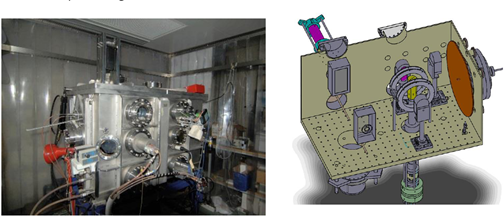
STORM
STrOngcRystallineelectroMagneticfields
National Responsible: Laura Bandiera (INFN Sezione di Ferrara)
Local Responsible: Davide De Salvador
It has been known since decades that the alignment of a beam of high-energy e- or photons with particular crystal direction involves a huge increase of radiation emission or pair production probability, respectively. While crossing an oriented crystal, such penetrating particles experience an electromagnetic field so strong that it leads to a huge enhancement of the e.m. shower development with consequent reduction of the radiation length, X0.
The main objective of the STORM project is a deep investigation of beam interactions with strong crystalline electromagnetic fields to exploit the huge enhancement of the photon emission and radiation length reduction for applications in accelerator and detector physics.
By the end of the project, we expect to get a measure of the γ emission enhancement in crystalline targets optimized to be used as radiators for the positron sources of future e+/e- colliders. In addition, we expect to fully characterize the light output enhancement in Cherenkov and scintillator crystals.
The success of the STORM project will open up several application scenarios in accelerators, e.g. in intense gamma and e+ source, and particle detectors, e.g. in the development of compact forward calorimeters/preshowers in fixed-target experiments, as well as in satellite-borne gamma-telescopes.
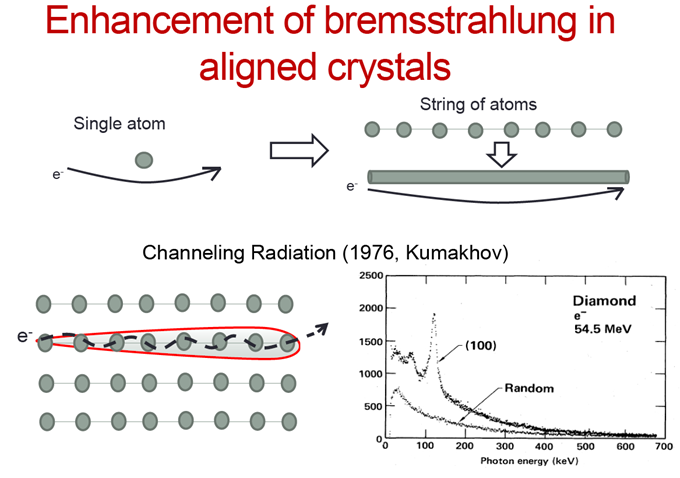
TeFeN
Thick Films for New generation of resonant cavities
National Responsible: Cristian Pira (INFN LNL)
Local Responsible: Cristian Pira
Superconducting radiofrequency (SRF) accelerating cavities are the heart of modern particle accelerators and Nb bulk cavities are now so efficient that they have reached the theoretical limits imposed by the material itself. However, cost reduction is a key issue and Nb thin-film cavities on copper are an excellent alternative when high accelerating fields are not required. The strong Q-slope (increase in losses as the accelerating field increases) limits the application of this technology at low accelerating fields applications (as for Quarter Wave Resonators in ALPI linac at LNL or elliptical 400 MHZ cavities at CERN in LHC).
The main goal of TeFeN experiment is to demonstrate the possibility to realize Niobium on Copper resonant cavities with performances comparable to the bulk Niobium technology and not affected by Q-slope using Nb thick films (40 microns instead of 2 microns of Nb thin films cavities).
On Nb thick film technology for 6 GHz cavities resonant cavities, nowadays, the next step is to make this process stable and reproducible, increase the performances in terms of Q and Eacc at the same levels of Nb bulk cavities, find a correlation between process parameters and RF performances, and then scale it towards cavities of standard size for the accelerators, as for example 1.3 GHz elliptical cavities.
To improve RF performances is mandatory first improve the surface quality of the copper substrate, which today is considered to be primarily responsible for limiting the performance of thin (and thick) film cavities.
Moreover, recent advances in the RF performances of the Niobium on Copper cavities, have highlighted the limiting effect of trapped magnetic flux, deeply studied in bulk Niobium cavities, but until now neglected in Niobium on Copper cavities.
During the three years of TeFeN experiment, LNL and Naples Section will study various aspects of Niobium on Copper superconducting films and will try to correlate them to the RF performances of the resonant cavities and the Q-slope phenomenon, starting from the results already achieved and the new studies carried out in the other international laboratories. Specifically, the TeFeN experiment will divided in three work packages, that investigate respectively:
WP1: development of the surface preparation of copper cavities;
WP2: Nb thick films coated via multilayer technique;
WP3: the effect of the residual magnetic field “trapped” in the superconducting film.
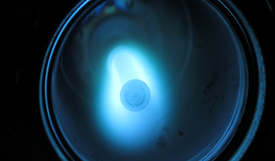
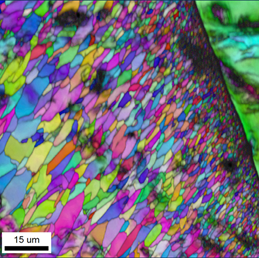
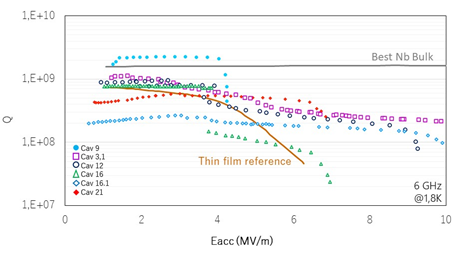
National Responsible: Francesco Taccetti (INFN Firenze)
Local Responsible: Demetre Zafiropolous
The working group is dedicated in particular to nuclear physics techniques without accelerators, non-destructive and non-invasive both molecular (Raman spectroscopy) and elemental (XRF) to obtain the complete structural and chemical characterization of the materials and pigments of artifacts.